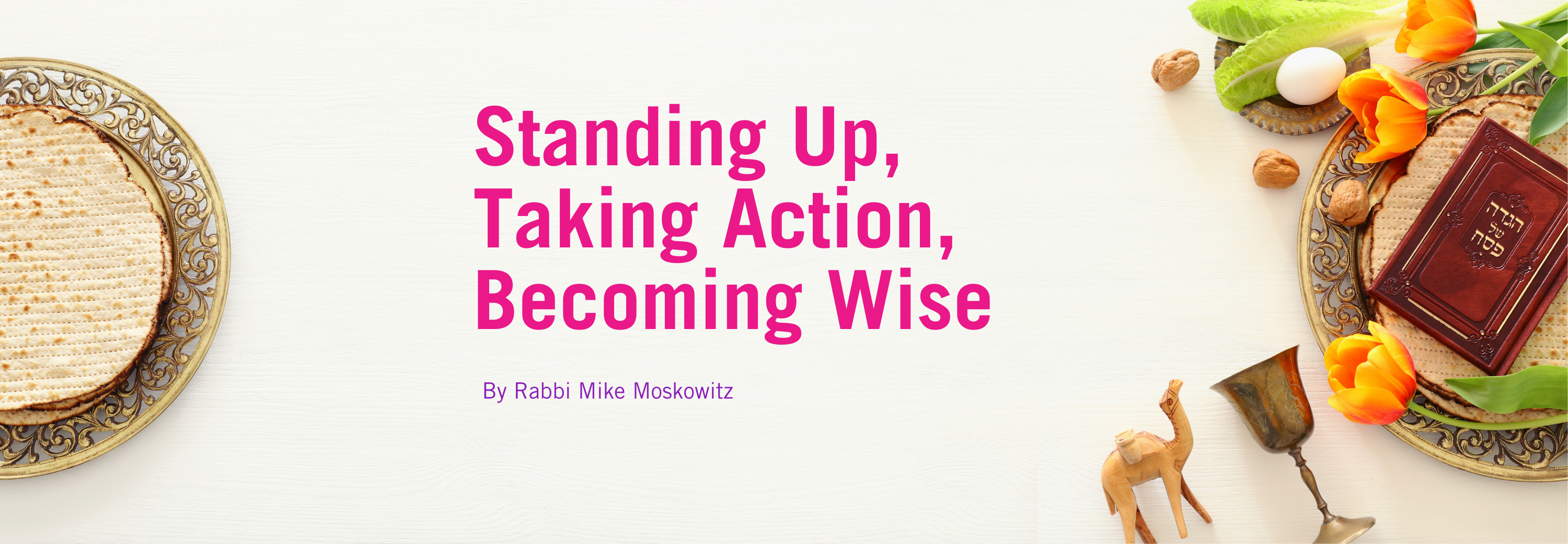
Standing Up, Taking Action, Becoming Wise: The Amidah and the Seder
וַיִּקְח֗וּ אֵ֚ת אֲשֶׁ֣ר צִוָּ֣ה מֹשֶׁ֔ה אֶל־פְּנֵ֖י אֹ֣הֶל מוֹעֵ֑ד וַֽיִּקְרְבוּ֙ כׇּל־הָ֣עֵדָ֔ה וַיַּֽעַמְד֖וּ לִפְנֵ֥י יְקוָֽק׃
They took what Moses had commanded to the front of the Tent of meeting; and the entire assembly approached and stood before Hashem.Leviticus 9:5
The Talmud1 teaches “וְאֵין ‘עֲמִידָה‘ אֶלָּא תְּפִלָּה,” that the word “amidah” (lit “stand”) is always a reference to prayer. It is one of the many reasons that the central prayer of each service is called the amidah.2 Rashi3 explains that prayer was necessary, after the eight days of inaugurating the Tabernacle, because after they built it, the Divine Presence still hadn’t come. Just as we learn that Moses turns to prayer when the physical is inadequate, the actions of our ancestors are meant to model and inform how we encounter similar struggles in later generations.4 Known in rabbinic literature as “מעשה אבות סימן לבנים,” or the happenings of our ancestors are lessons for us, their decedents, these “simanim,” or signs, are notes of remembrance that are teeming with acquired wisdom, preserved as part of our collective inheritance. Praying, after all of the material effort and investments had been made to sanctify the Tabernacle, signals to us the supplemental nature of prayer. We are meant to pray – in addition to taking action, not in lieu of it. This is true even in situations where the only appropriate thing to do is pray. Psalm 19:15 reads “יִ֥הְיֽוּ לְרָצ֨וֹן אִמְרֵי פִ֡י וְהֶגְי֣וֹן לִבִּ֣י לְפָנֶ֑יךָ – “May the words of my mouth, and the prayer of my heart, be acceptable to You” which is the supplication that we offer at the end of each amidah prayer. This is also reflected in the kaddish, after the amidah, when we ask God to accept the prayers of all people – “תִּתְקַבֵּל צְלוֹתְ֒הוֹן וּבָעוּתְ֒הוֹן דְּכָל בֵּית יִשְׂרָאֵל,” just as Moses gathered “כׇּל־הָ֣עֵדָ֔ה,” the entire congregation before Hashem. Perhaps there is no greater concentration of “simanim” in Jewish ritual than at the Seder on the night of Passover. There are 15 “official” simanim, each the placeholder for thousands of years of ancient wisdom for us to unpack and expand upon. However, one of them is not like the others. The Haggadah begins with the list of the 15 instructions: Kadesh, Urchatz … until the final stage of the Seder Nirtzah (lit. ” accepted”) – which isn’t so much an action item as it is an aspiration for our offering to be accepted. The few short sentences of the Nirtzah text, that introduce the songs that conclude the Seder, acknowledge that we can now pray for redemption because we have organized and done everything we can, “כְּכָל מִשְׁפָּטוֹ וְחֻקָּתוֹ.” After sharing thoughts and exchanging ideas, we conclude the process of reordering with an invocation for action – “נִזְכֶּה לַעֲשׂוֹתוֹ – may we merit to perform.” The final step of organizing the Seder is to pray that it is successful. The actions of our ancestors are signs for us to learn how to act in transformative ways. These simanim connect us to the lived experiences of those who came before us and we invite them to become our teachers when we open ourselves with humility to learn from them. In Hebrew, “simanim – סימנים” has a numerical value of 2105 and speaks to the ongoing struggle for liberation and freedom that we are tasked with continuing. “Seder – סדר” represents the three hidden aspects of the Pardes – פרדס, albeit out of order6. Spiritual journeys into the esoteric are meaningful when we can harness those experiences in reconfiguring the world of action. We study Torah in the hopes of becoming talmidei chachamim, not simply wise students – but students, and practitioners, of wisdom. One of the motivating lessons for us today, in our continued stand against all sources of oppression, is that we are accompanied and bolstered by all of the unanswered prayers of those who came before us in this struggle. Those prayers, that are still standing in heaven, are not the ignored pleas of earlier generations that were rejected, but are thoughts and prayers from a time that wasn’t yet worthy of a Heavenly intervention because of the lack of human engagement. When we channel our communal activities towards the holy vision of freedom, we create new pathways for all prayers to be fulfilled. 1 Berachot 6b. 2 Not simply because we stand when we pray. 3 On 9:23 quoting Torahs Kohanim. 4 See Bereshit Rabbah 48:7. 5 See introduction for an expanded explanation on the numerical significance of 210. 6 Pardes is seen as an allusion to peshat (plain meaning), remez (allusions), derash (homiletical explication), sod (mystical secrets).